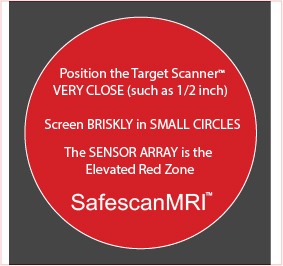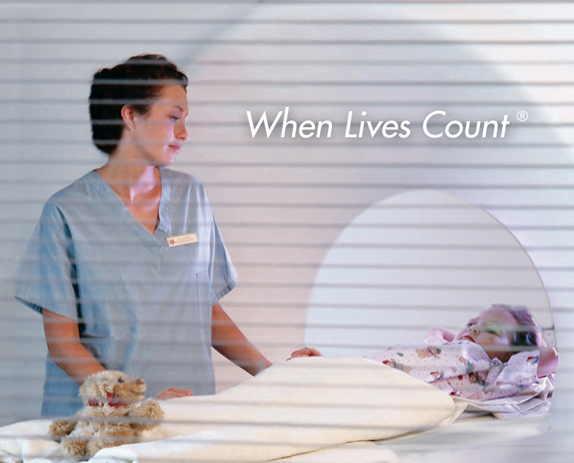A practical and affordable instrument for MR Safety:
FERRALERT™ TARGET SCANNER™
The FERRALERT™ TARGET SCANNER™ fully complies with MR Safety mandates from the American College of Radiology (ACR), The Joint Commission (TJC), VA Healthcare, and Facilities Guidelines Institute (FGI).
|
FERROMAGNETIC ONLY DETECTION
|
We are honored to have the handheld TARGET SCANNER™ in many hundreds of very serious MRI facilities - including major University Hospitals, Community Hospitals and Regional Medical Centers, numerous VA Medical Centers, Military Hospitals in the United States and overseas, many renowned Children's Hospitals, and Free-standing MRI centers. The TARGET SCANNER™ is utilized in 17 of the 'Top 20' hospitals in America.
TARGET SCANNER™ battery-operated EAGLE®
- The rechargeable battery-operated EAGLE has the advantage of not requiring an AC power outlet, increasing the practicality of this instrument for many MRI centers desiring siting flexibility. The battery-operated EAGLE is now the version of choice for many renowned and very serious MRI facilities.
FACTS ABOUT THE TARGET SCANNER™
Question:
Can the TARGET SCANNER™ be used for the chest area?
Answer: YES
- We do not actively market the TARGET SCANNER for threats inside the body. Incidentally, however, a number of pacemakers or defibrillators have been found in patients who absolutely denied having these devices - sometimes to 2 and even 3 MR Technologists!
- To maximize safety for your patient, screen the chest area AFTER you have asked your patient if he or she has a pacemaker or defibrillator. If the patient denies having one of these devices, you may certainly screen this area.
- The passive NON-RADIATING DC magnetic field of the TARGET SCANNER is many times less than DC permanent magnets sometimes used for ferromagnetic threat location on patients (‘MRI Test Magnet’ = typically 2,000 – 3,000 G.) – and many many times less than the DC field of the MR magnet itself - for which the patient has been medically cleared (15,000 – 30,000 G).
- Nevertheless, as a safety precaution, do not allow the TARGET SCANNER to rest on the chest for prolonged periods of time. However, screen the chest area AFTER you have medically cleared your patient for MRI.
PACEMAKERS AND NEUROSTIMULATION DEVICES: As stated above, while we do not market the TARGET SCANNER for finding pacemakers/neurostimulators and other objects within the body of the patient, the TARGET SCANNER has incidentally found a number of pacemakers in patients who absolutely denied them; and, based upon this historical denial, were medically cleared to enter the huge field of the MRI machine (15,000 - 30,000 G).
Because of the TARGET SCANNER – used as a second line of defense AFTER the patient was medically cleared for MRI – these patients were saved from the potentially ominous consequences of undergoing MRI. For such patients, the TARGET SCANNER prevented a potential disaster.
NOTE TO PATIENTS:
- As stated above, the TARGET SCANNER is not intended or marketed for determining whether metallic objects INSIDE the body are ferromagnetic or nonferromagnetic.
- The decision to have an MRI - or not to have an MRI - is a medical decision, based upon an analysis of the risk of the MRI procedure vs. the potential benefit involved. This decision must be between you as the patient and your doctor.
- If there is any issue about safety, please ask your doctor if there is an alternative to MRI which would provide the required medical information. And if your doctor can find out about the implanted metallic material from the manufacturer, this can be very helpful.
- If there are unanswered questions regarding the implant in question, it is always best to do what is safest - again, a decision made between you and your doctor.
Question:
Can the TARGET SCANNER™ be used for the head area?
Answer: YES
- Screening the head area is recommended and advised - but to be absolutely safe, avoid rubbing the TARGET SCANNER directly against the eye.
- The reason for this is that the small field of the TARGET SCANNER (many times LESS than the sometimes used 'MRI Test Magnet'), could, at least potentially, move a ferromagnetic object if deep within the eye. We have done experiments with human eye bank eyes demonstrating that this is extremely unlikely, because the TARGET SCANNER's field is so small relative to the field required to move an intraocular particle.
- And it is very rare to have ferromagnetic material deep within the eye itself (intraocular), especially without serious ocular manifestations -- including severe inflammation and usually profound loss of vision.
Note: Corneal FM foreign bodies (i.e., embedded in the cornea but not intraocular) are common in certain professions, such as welding and shop work. Patients with corneal foreign bodies almost always have pain and excessive tearing - symptoms that there is something wrong with their eye. Patients exhibiting these ocular symptoms must first and without delay be referred to a competent eye doctor prior to MRI.
Question:
Is the field of the TARGET SCANNER™ 'strong'?
Answer: NO
- TheTARGET SCANNER employs a small DC permanent magnet to enhance detection capability, especially for non-premagnetized 'ferromagnetically-hard' threats.
- The use of this field increases sensitivity-detectability significantly vs. not using this field, and rather relying instead only on the Earth’s field and any fringing field in the area.
- The small passive DC NON-RADIATING field of the TARGET SCANNER does NOT affect in any way MRI quality, nor will it erase credit cards or affect cell phones.
- Other examples of a passive non-radiating field emitting no RF are a refrigerator magnet, and the small magnet sometimes given out in meetings by Junk Architects.
Note: Metal detectors DO have a radiating magnetic field, although in fairness to most metal detector companies, this is not of great clinical significance as long as caution is exercised.
- The TARGET SCANNER’s field is many times smaller than the ‘MRI Test Magnet’ sometimes used for patient pre-screening. The MRI ‘Test Magnet’ can have a field as high as 2,000 - 3,000 G.
What about the field of the MRI, for which the patient has been medically cleared?
- For a duration of several seconds (TARGET SCANNER) vs. 30 minutes (MRI), the relative time differential is some 300 times.
TARGET SCANNER: small non-radiating DC magnetic field, which decreases to 1 G. at 1 foot
Duration of test: 6 seconds or less per area
MRI: huge DC magnetic field: 15,000 - 30,000 G.
Duration typically: 20-35 minutes
Question:
How is the TARGET SCANNER™ properly used?
Answer:
- The proper use of the TARGET SCANNER is very important, and if not used properly, it will not be nearly as effective.

- Moving the TARGET SCANNER briskly in small 5-inch diameter circles gives the greatest sensitivity.
- Waving up-and-down or side-to-side in long broad strokes is strongly discouraged because this is NOT as sensitive as screening briskly in small circles.
- And it is not necessary, and in fact, undesirable, to rub the instrument directly on the patient's skin, and we do not recommend this.
- It is important to get close, however, as the signal from a ferromagnetic object decreases to the cube of the distance, as you know. 3 times further away is 3 x 3 x 3 = 27 times reduction in sensitivity.
Question:
How is the TARGET SCANNER™ cleaned between uses?
Answer:
The TARGET SCANNER is classified as 'Reusable Medical Equipment,' and, as such, can be readily cleaned between uses with an alcohol wipe or sponge, or other standard medical disinfectant solution.
Question:
Does the TARGET SCANNER™ require periodic maintenance?
Answer:
- The TARGET SCANNER goes through an alarm test cycle every time it is turned on.
- No preventative maintenance is required, but it is recommended to visually inspect the instrument before every use.
- To make certain that the instrument is in proper working order, it should therefore be turned off after every use, thus allowing the alarm test cycle to occur.
- An excellent and readily available test object is a paper clip firmly affixed to a block of wood. The paper clip should elicit an alarm response.
- If any material, such as a bobby pin, is attached to the TARGET SCANNER's elevated red area (the scanning area), the alarm test cycle will show that the instrument is NOT ready for clinical screening.
CONSCIENTIOUS RISK MANAGEMENT
Not only does the TARGET SCANNER go through an alarm test cycle every time that it is turned on - but an excellent double-check is to use the TARGET SCANNER on the paper clip/wood block as described in the above section.
FORMAL CHECK COMPLETE WITH WRITTEN DOCUMENTATION: Frequently checking - and documenting - the alarm test cycle is a recommended protocol to make certain that the TARGET SCANNER is working correctly.
★ ★ ★ ★ ★
TARGET SCANNER™ - Clinical Implementation
Mednovus, Inc. has been working closely with Dr. Emanuel Kanal, Professor of Radiology and Neuro-Radiology at the University of Pittsburgh Medical Center (UPMC), and the lead author of the ACR MR Safety Guidance Documents, for needs assessment, practical clinical implementation requirements, and formal testing.
On Dr. Kanal's recommendation, TARGET SCANNERS have been purchased for all the UPMC facilities (42 and counting) in the greater Pittsburgh area. This is from Dr. Kanal:
I am most pleased with the sensitivity, portability, performance, and affordability of the TARGET SCANNER handheld ferromagnetic detector and will continue to use it as an integral part of my patient safety screening.
| Emanuel Kanal, MD, FACR, FISMRM Professor of Radiology and Neuroradiology University of Pittsburgh Medical Center Pittsburgh, Pennsylvania |

